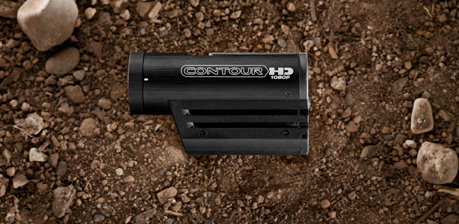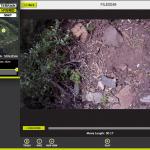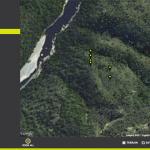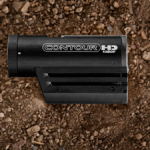 Contour gave us some cameras to test. Hardcore cameras. We could have rented a trampoline and partaken in some sweet, botched somersault action, but no – in order to really put the Contour HD and Contour GPS rugged action cams to the test, we had to take things to the next level – by renting canoes and going on a mental ‘Deliverance’ style camping trip.
Contour gave us some cameras to test. Hardcore cameras. We could have rented a trampoline and partaken in some sweet, botched somersault action, but no – in order to really put the Contour HD and Contour GPS rugged action cams to the test, we had to take things to the next level – by renting canoes and going on a mental ‘Deliverance’ style camping trip.
True story – we almost died.
Features
For comparison purposes, we brought our GoPro HD rugged camera. The Contour HD and the GoPro HD are pretty much on par in the spec department, but the Contour GPS really steps it up when it comes to performance.
Not only can the GPS model track your movement when you hit record, you can also pop in a ‘ConnectView’ card and connect the camera to your iPhone (Android in the works apparently) via Bluetooth. This is doubly awesome, as it allows you to set up the shot, but also change the camera settings on the go. There is a noticeable lag on screen, and the connection is lost when recording, but it’s actually helpful – not just a gimmick.
Both Contours also feature a rotating lens with a laser leveling guide. We were initially really impressed with this in the office, but found the lasers to be a bit weak out in the wild. Halfway up the mountain we switched to the Contour GPS and neglected to check if the lens was aligned correctly – as a result all of the footage ended up being shot vertically (think iPhone video). A rookie error for sure, but frustrating nonetheless.
Setup
When it comes to setting up the camera, the Contour GPS wins hands down.
The Contour GPS comes with two configurable presets that can be setup on your PC or with your iPhone (with ConnectView). The level of control when setting up the camera is impressive, but shouldn’t be too overwhelming for new users. Any fiddling with settings will update the estimated battery life and recording time.
The GoPro HD on the other hand is entirely configurable on the camera itself – which in theory sounds great, but is actually fairly tedious and quite intimidating for new users. All settings have a shorthand code which will need to be memorised.
Usability
When it comes to powering on and recording, both Contour models and the GoPro HD try and keep it as simple as possible. Where the GoPro HD favours buttons, the Contours have a start/stop slider, which we found to be much more intuitive and tactile.
When the camera is strapped to your head or helmet, just touch the camera and you know instantly if it’s recording or not – this check is impossible with the GoPro HD without asking a mate, or investing in a pocket size mirror.
Battery Life
The battery life is comparable between brands – we tend to get about two to three hours of on/off recording. We’ve recently been able to squeeze a bit more out of the GoPro HD with the firmware introduction of ‘one touch recording’, which eliminates standby – the camera is only on while recording.
This does not seem possible as yet with either of the Contours.
Quality
When it comes to video quality, it’s hard not to be subjective. Ultimately, we prefer the GoPro HD. It has a much bigger lens, which basically means more light, deeper colour and a wider viewing angle without the blurred edges.
That said, neither the Contour HD, the Contour GPS nor the GoPro HD dealt well with low light situations, despite all three cameras having a 5MP sensor on board.
With regards to sound, the GoPro HD is again leaps and bounds ahead both of the Contours in all conditions – especially in its underwater housing, where the Contour cameras lose sound altogether.
But again, even though the GoPro HD has superior audio, it’s still not that great and is generally better faded out to very subtle background noise anyway.
Accessories
Both brands have a very similar selection of accessories, with none being compatible with the other due to the drastically different mounting structure.
Software
GoPro have nothing on offer (yet), whereas Contour provides it’s own proprietry ‘Contour Storyteller’, which is a bit hit and miss on OS X.
It handles the basics, like the ability to import and watch clips, mark your favourite bits as ‘awesome’, load them up with all sorts of tags and information, then upload it for free to the Contour site for sharing. It also has some great features like an interactive Google map, which tracks your speed and elevation while you’re previewing the clip.
That being said, it seems to be designed for incredibly simple editing tasks and we wouldn’t recommend using it for any projects over a minute or two.
The UI is a little buggy (can’t grab scrubbers from time to time) and we managed to crash the app a few times by simply moving between menus quickly. There is also no way to export a video of the map tracking – it only appears in the app, and when uploaded to their site.
Conclusion
The Contour GPS has an awesome feature set and really solid usability – but when it came time to review the footage, the GoPro HD came out on top (even with a dirty lens).
The Contour GPS map tracking and ConnectView are both incredible innovations for the rugged camera market, and admittedly it’ll be hard to go back to button mashing through menus – but when it comes time to dropping your cash over the counter, image quality has to be king.




